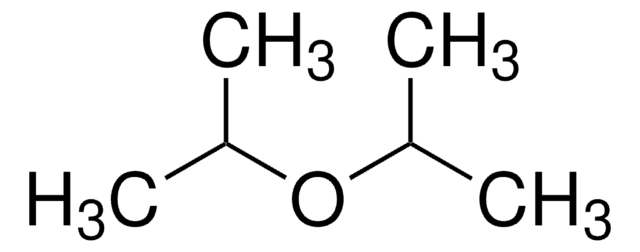Wichtige Dokumente
38270
Diisopropylether
puriss. p.a., ≥98.5% (GC)
Synonym(e):
Isopropylether
About This Item
Empfohlene Produkte
Dampfdichte
3.5 (vs air)
Dampfdruck
120 mmHg ( 20 °C)
Qualität
puriss. p.a.
Assay
≥98.5% (GC)
Form
liquid
Selbstzündungstemp.
827 °F
Enthält
~0.001% 2,6-di-tert-butyl-4-methylphenol as stabilizer
Expl.-Gr.
1-21 %, 100 °F
Methode(n)
GC/GC: suitable
Verunreinigungen
≤0.001% peroxides (as H2O2)
≤0.005% free acid (as C2H5COOH)
≤0.1% water
≤0.5% isopropanol (GC)
Abdampfrückstand
≤0.002%
Brechungsindex
n20/D 1.367 (lit.)
n20/D 1.368
bp
68-69 °C (lit.)
mp (Schmelzpunkt)
−85 °C (lit.)
Dichte
0.724 g/mL at 20 °C
0.725 g/mL at 25 °C (lit.)
Kationenspuren
Al: ≤0.5 mg/kg
Ba: ≤0.1 mg/kg
Bi: ≤0.1 mg/kg
Ca: ≤0.5 mg/kg
Cd: ≤0.05 mg/kg
Co: ≤0.02 mg/kg
Cr: ≤0.02 mg/kg
Cu: ≤0.02 mg/kg
Fe: ≤0.1 mg/kg
K: ≤0.5 mg/kg
Li: ≤0.1 mg/kg
Mg: ≤0.1 mg/kg
Mn: ≤0.02 mg/kg
Mo: ≤0.1 mg/kg
Na: ≤0.5 mg/kg
Ni: ≤0.02 mg/kg
Pb: ≤0.1 mg/kg
Sr: ≤0.1 mg/kg
Zn: ≤0.1 mg/kg
SMILES String
CC(C)OC(C)C
InChI
1S/C6H14O/c1-5(2)7-6(3)4/h5-6H,1-4H3
InChIKey
ZAFNJMIOTHYJRJ-UHFFFAOYSA-N
Suchen Sie nach ähnlichen Produkten? Aufrufen Leitfaden zum Produktvergleich
Allgemeine Beschreibung
Anwendung
Ähnliches Produkt
Signalwort
Danger
H-Sätze
Gefahreneinstufungen
Flam. Liq. 2 - STOT SE 3
Zielorgane
Respiratory system
Zusätzliche Gefahrenhinweise
Lagerklassenschlüssel
3 - Flammable liquids
WGK
WGK 1
Flammpunkt (°F)
-20.2 °F - closed cup
Flammpunkt (°C)
-29 °C - closed cup
Hier finden Sie alle aktuellen Versionen:
Besitzen Sie dieses Produkt bereits?
In der Dokumentenbibliothek finden Sie die Dokumentation zu den Produkten, die Sie kürzlich erworben haben.
Unser Team von Wissenschaftlern verfügt über Erfahrung in allen Forschungsbereichen einschließlich Life Science, Materialwissenschaften, chemischer Synthese, Chromatographie, Analytik und vielen mehr..
Setzen Sie sich mit dem technischen Dienst in Verbindung.




